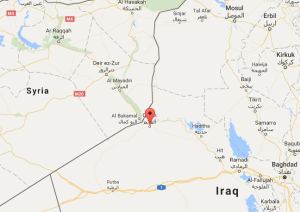The twists and turns of the election, Hillary’s corruption, liberal derangement over Trump’s triumph, etc. have pushed a lot of other news stories onto the back-burner.
One of the big ones being: What the hell is happening in the war against the Islamic State?
It looks like I’m not the only one to have taken my eye off the ball. Back when Bush was President, there was heavy mainstream media reporting on conflicts in the Middle East. But ever since Obama’s Iraq pullout engendered the rise of the Islamic State, American reporting on the conflict has been (at best) sporadic.
Which is why I was surprised to see reports that Kurdish-led fighters were closing in on the Islamic State’s de-facto capital of Raqqa:
As the Mosul offensive drags into its second month, another fight is raging 450km to the west around Islamic State’s de facto capital at Raqqa, on the Euphrates River in northern Syria. The battle is already a tragedy for Raqqa’s 320,000 civilians, who’ve suffered under brutal Islamic State occupation for more than three years. Many have fled, with thousands crowding into already overflowing refugee camps since the latest fighting began, and others fleeing across the hills towards the Iraqi border even as night-time temperatures plunge below freezing. Their lives, like those of families still in the city, are about to get even harder.
The battle for Raqqa will shape the Syrian war throughout the coming year. Though smaller than the vast offensive around Mosul, it will be even more significant. It may decide the fate of Islamic State’s “caliphate” in Syria and will set the tone for the incoming Trump administration’s dealings with Turkey and Russia, two critical relationships that will drive events in the region and beyond.
During a visit to the Middle East last week, I spoke to Syrian, Kurdish, Iraqi and American leaders involved in the campaign. They told me that while the military offensive is progressing about as well as anyone expected, the politics are proving characteristically complex.
The troops fighting Islamic State in Raqqa come from the Syrian Democratic Forces, a rebel coalition backed by the US, among other countries. SDF units have received a stream of weapons, training and advisers since last year. Supported by coalition airstrikes, they attacked Raqqa early last month, timing the offensive (known as Operation Euphrates Wrath) to coincide with the Mosul assault, to stop Islamic State shifting reinforcements between fronts.
The SDF has achieved considerable battlefield success. In the past month it has cleared 600sq km of rural terrain in Raqqa province, recapturing 45 villages and expelling hundreds of Islamic State fighters. Many recovered settlements are ruined, however, their populations massacred or driven off by Islamic State, or bombed out by Bashar al-Assad’s regime in previous fighting.
The frontline sits just north of Raqqa city, in Ayn Issa district, where heavy combat (including coalition airstrikes called in by observers on the ground) has killed as many as 200 Islamic State fighters in the past two weeks.
In the same timeframe, SDF spokesmen announced the recapture of the towns of Hazima, al-Taweelah and Tel al-Samman, north and west of Raqqa, bringing the SDF main force within 25km of the city’s outskirts, with reconnaissance teams pushing forward to the edge of town.
Islamic State resistance is increasing as SDF advances, and most commanders expect a ferocious fight against a determined enemy once they reach the fortified downtown area.
As the investment of Mosul has been going on for weeks, the battle for Raqqa will probably be at least equally slow and grinding, especially given the difficulties inherent in managing a diverse force of various factions:
More than 25,000 SDF members — by far the largest faction in a force of about 30,000 — come from the People’s Protection Units (YPG) and the affiliated Women’s Protection Units (YPJ, an all-female combat brigade of 7000 troops). SDF also includes a few hundred Arab fighters from the Shammari tribal confederation, plus an Assyrian Christian militia and a small ethnic Turkmen force. The Shammari have a longstanding blood feud with Islamic State, which has massacred their men and boys and enslaved women and girls as it seeks to intimidate tribes in its region of influence. Christians and Turkmen are fighting for survival against Islamic State, which has engaged in genocidal slaughter against both groups wherever it has gained control. There also is a small secular nationalist force drawn from regime military defectors, the Free Officers Union. But these are minorities, perhaps 15 per cent altogether, in an alliance that is overwhelmingly Kurdish.
Evidently the fighting is going poorly enough for the Islamic State that their spokesman urged their own soldiers not to flee Raqqa and Mosul. (That would be their new spokesman, the old one having been removed from office by a Hellfire missle.)
There’s also indications that the Iraqi forces closing in on Mosul have cut off escape routes for Islamic State fighters, though Islamic State forces just launched a counterattack.
Some have suggested that the Islamic State is preparing to retreat to a desert stronghold, in Wilayat al-Furat near the Iraq-Syrian border if it’s ejected from both Raqqa and Mosul. (This, as far as I can figure, is about where it is.)

More far afield, Libyan militias backed by American airstrikes said they have cleared Sirte, the stronghold of the Islamic State in Libya.
One thing that may be making battlefield progress against the Islamic State possible: Cheap oil prices. Without excess petrodollars to spend, the Islamic State’s backers on the Arabian peninsula (not to mention Anatolia) may not have the spare cash to prop up their miniature caliphate.
That said, the war against the Islamic State is far from over, and expected it to drag on into the Trump Presidency.
Tags: Iraq, Islamic State of Iraq and Syria, Jihad, Kurds, Libya, Military, Mosul, Raqqa, Syria, Syrian Democratic Forces